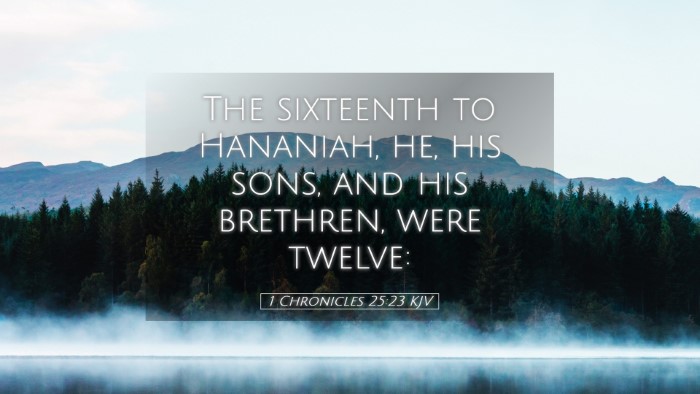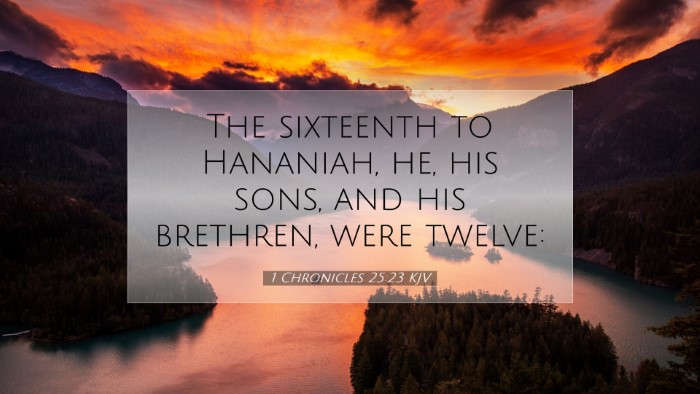Commentary on 1 Chronicles 25:23
1 Chronicles 25:23 states: "The sons of Asaph, Zaccur, and Joseph, and the sons of Jeduthun, Gedaliah, and Zeri, and the sons of Heman, Bukkiah, and Mattaniah." This verse provides a glimpse into the organization of the Levitical musicians and their lineage, highlighting key families responsible for temple worship.
Historical Context
Throughout the Chronicles, the author meticulously documents the establishment of worship practices in ancient Israel following the Babylonian Exile. The emphasis on music and its practitioners mirrors the Levites' essential role in the religious life of Israel. As the temple was central to Jewish identity, the organization of those who led worship through music was vitally important.
Analysis of Key Figures
- Asaph: Recognized as one of the principal musicians, Asaph's descendants were charged with specific musical responsibilities. His psalms, rich in theological insight, provide a deeper understanding of worship's role in Israel's life.
- Jeduthun: A prominent figure in temple service, Jeduthun represents a lineage dedicated to praise through music, illustrating the importance of worship leaders in confronting societal challenges with faith and music.
- Heman: Not only a musician but also a seer, Heman is an example of the multifaceted roles that worship leaders played. His lineage contributed to both music and prophetic insight, reinforcing the idea that worship is connected to the larger narrative of God's guidance.
Theological Implications
This verse reveals key theological themes in the practice of worship:
- Divine Order: The structure outlined highlights God's desire for orderliness in worship. Each lineage with its unique role showcases the intention behind communal worship efforts.
- Community in Worship: The involvement of multiple families in the Levitical choir indicates that worship is not an individualistic practice but a communal endeavor where contributions vary yet harmonize for a greater purpose.
- Role of Music: Music is portrayed as an essential element of worship, underscoring its power to affect the heart and spirit of the worshippers, providing a medium through which congregational expression is realized.
Commentary Insights
Matthew Henry: In his commentary, Henry elucidates the dedication observed in these family lineages to their ministry roles, emphasizing how they were not merely musicians but caretakers of the spiritual atmosphere of worship. Their music sought to honor God and lead the congregation into a deeper experience of His presence.
Albert Barnes: Barnes notes the strategic organization of families, suggesting that this structuring serves as a model of teamwork and cooperation. Each family's name reflects a legacy of faithfulness, reminding leaders today of the importance of passing on spiritual responsibility through generations.
Adam Clarke: Clarke emphasizes the significance of worship in both private and communal settings. He draws attention to the lineages of Asaph and Heman, noting their contributions to the Psalms. This serves as a reminder that worship should be rooted in scriptural truth and that musical expression ought to reflect the heart's understanding of God’s character.
Lessons for Modern Application
As we reflect on 1 Chronicles 25:23, several lessons emerge that are relevant for pastors, students, and theologians:
- Value of Heritage: Understanding the historical context of worship leaders allows contemporary believers to appreciate their faith tradition and understand their responsibility for future generations.
- Humility in Leadership: Just as these families understood their place in the grand design of worship, leaders today are reminded of the importance of teamwork and the humility that accompanies service to God and the church body.
- Faithful Service as a Form of Worship: The dedication demonstrated by these families reminds modern worshippers that faithful service in various capacities is a form of worship that God honors.
Conclusion
1 Chronicles 25:23 offers a rich tapestry of insight into the structure and intention behind worship in ancient Israel. The names mentioned are not mere historical footnotes; they represent an enduring legacy of faithful service in music ministry. As worship leaders today embrace this divine calling, they become part of a longstanding tradition of honoring God through music, fostering a vibrant community of faith.


